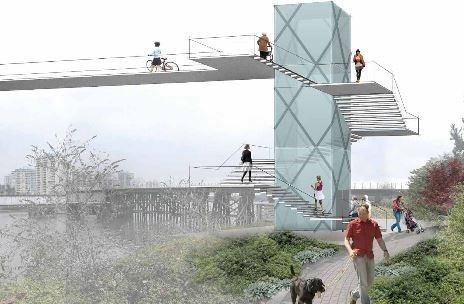The city is working to answer the “million-dollar question” of how to reconcile the needs of residents, cyclists and marine carriers and still accomplish its goal of building a pedestrian bridge from the Quay to Queensborough, says Mayor Jonathan Cote.
Last January, the city determined that a drawbridge was the best plan for linking the two neighbourhoods. After further talks with marine carriers (tug boat operators), Port Metro Vancouver and Transportation Canada, the city had to revise the location and height of the Q2Q crossing.
“Although those organizations had been informed from the very beginning in terms of our discussions, it wasn’t until that point that they started to become very vocal in terms of their interest and their concerns with the project,” Cote said. “Given their important role in terms of maintaining shipping access through the area, they do carry a lot of weight in terms of what could be approved and allowed to be built in the area.”
Instead of being located near the submarine park and existing railway bridge, the proposed Q2Q has moved further downstream. In addition, the plan now includes elevator towers on the Quayside esplanade and Queensborough boardwalk that would take cyclists and pedestrians up to the bridge.
While the conceptual drawings were created to give people a sense of the scale of the Q2Q bridge when viewed from the boardwalk or waterfront condos, Cote said residents on both sides of the river have voiced concerns about the visual impacts of the elevator towers. He said cyclists have expressed concern that the crossing “may not be as useful” as previously contemplated as they’ll now have to use an elevator to access the bridge.
Mark Allison, the city’s manager of strategic issues and sustainability, said the next steps are to finalize the design specifications for the bridge, including design criteria related to appearance and neighbourhood impacts and to consult with the community on these specifications. The city will also seek updated cost estimates in light of recent bridge code amendments and the height and width required by Port Metro Vancouver and Transport Canada.
“I have never shied away from stating that I have been a strong advocate for building that permanent connection between Queensborough and Quayside, and really see the tremendous recreational, but also transportation, benefits of being able to connect our neighbourhoods that way,” Cote said. “Having said that, I’m not prepared to write a blank cheque for this project.”
Fast fasts
* A bascule bridge (drawbridge) is still the concept for the crossing to allow tall marine traffic to pass. Discussions with marine carriers, Port Metro Vancouver and Transport Canada resulted in a requirement that the bridge be located downstream from the previous proposal for safety reasons and be 14.5 metres from the river to allow the bridge to be available for users most of the day.
* In the latest plan, people would use elevators to access the bridge on either side of the bridge.
* The entry point of the elevators would be approximately eight metres above the existing Quayside esplanade and Queensborough boardwalk, or about three storeys in height.
* The city has budgeted approximately $11.5 million for the bridge in the five-year financial plan, of which $6.3 million is available from DAC (casino) funding. The original DAC agreement included $10.3 million for a pedestrian connection between Queensborough and the Quay but some of those funds were reallocated to Anvil Centre construction.
* The original deadline for building the pedestrian bridge was between 2013 and 2015, but last year the province extended the use of DAC funding to the end of 2017. More recently, it indicated it would extend the deadline to 2020.



